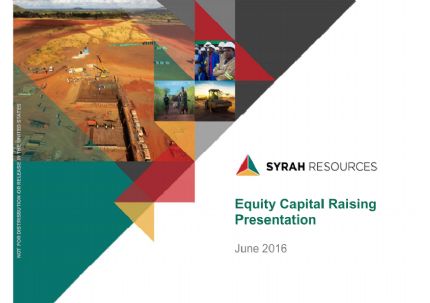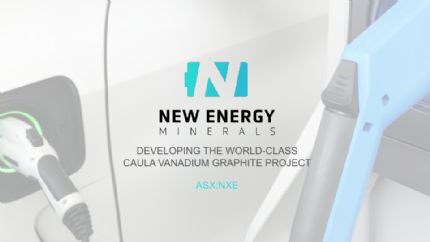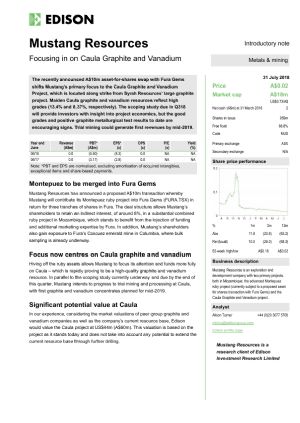 Caula Testwork Delivers High Grade Vanadium Concentrates
Caula Testwork Delivers High Grade Vanadium Concentrates
Sydney, Oct 3, 2018 AEST (ABN Newswire) - Mustang Resources Ltd ("Mustang", the "Company") ( ASX:MUS) (
ASX:MUS) ( GGY:FRA) (
GGY:FRA) ( MTTGF:OTCMKTS) is pleased to announce that preliminary vanadium testwork has produced outstanding recovery and concentrate results, from bench-scale metallurgical testwork, on ore from the Fresh Zone of the Caula Vanadium-Graphite Project in Mozambique. Through the integrated graphite and vanadium flowsheet, the testwork utilised Wet High Intensity Magnetic Separation (WHIMS) on composite samples, which resulted in a Cleaner Concentrate grade of 1.66% V2O5, with a recovery rate of 80.6%. Results were achieved from an overall feed grade of 0.401% V2O5, before graphite extraction. The Caula Project is located along strike from Syrah Resources' (
MTTGF:OTCMKTS) is pleased to announce that preliminary vanadium testwork has produced outstanding recovery and concentrate results, from bench-scale metallurgical testwork, on ore from the Fresh Zone of the Caula Vanadium-Graphite Project in Mozambique. Through the integrated graphite and vanadium flowsheet, the testwork utilised Wet High Intensity Magnetic Separation (WHIMS) on composite samples, which resulted in a Cleaner Concentrate grade of 1.66% V2O5, with a recovery rate of 80.6%. Results were achieved from an overall feed grade of 0.401% V2O5, before graphite extraction. The Caula Project is located along strike from Syrah Resources' ( ASX:SYR) world-class Balama graphite-vanadium project in Mozambique.
ASX:SYR) world-class Balama graphite-vanadium project in Mozambique.
Key Points
- Preliminary metallurgical testwork focussed on vanadium recovery has produced outstanding results, through bench-scale Wet High Intensity Magnetic Separation (WHIMS), after extraction of graphite from the same feed material
- Preliminary WHIMS testwork on composite samples from the Fresh Zone has resulted in a Cleaner Concentrate grade of 1.66% V2O5 at a recovery rate of 80.6%. Results were achieved from an overall feed grade of 0.401% V2O5 before graphite extraction
- Combined Cleaner and Scavenger Concentrates from WHIMS resulted in a recovery rate of 90.8% with a concentrate grade of 1.42% V2O5
- These excellent preliminary vanadium metallurgical results from the WHIMS testwork further demonstrate the potential of combined vanadium and graphite extractions from the Caula Project
- Quantitative mineralogy studies are underway to investigate mineral associations in vanadium concentrate, with initial studies confirming micaceous nature of the concentrate
- Extraction process for vanadium hosted in mica and silicate minerals are significantly different from vanidiferous titanomagnetite (VTM) deposits
- Ongoing metallurgical testwork is aimed at improving vanadium recovery concentrate grades and recovering high-purity (>98% V2O5) vanadium pentoxide
- Caula Scoping Study nearing completion with report expected around 5 October 2018
Mustang Resources' Managing Director Dr. Bernard Olivier commented: "These preliminary vanadium concentration and recovery results achieved through a simple magnetic separation process (WHIMS) are truly outstanding. Concentration through a WHIMS process is highly economical compared with other concentration processes and requires no expensive nor complicated reagents. I urge investors to compare our exceptional preliminary concentrate grades of around 1.7% V2O5 and 81% recoveries with other vanadium-dedicated projects. Furthermore, our vanadium grades and recoveries are in addition to the exceptional grade and quality of graphite extracted from the same material."
The Caula Project is in the unique position of hosting both exceptional quality and high-grade graphite (up to ~99% TGC concentrates and 68% large to jumbo flake sizes) (see Note 1 below), in addition to high grade vanadium, within the shallow mineralisation of the same deposit. Magnetic separation testwork has been performed on fresh rock (Fresh Zone) samples at a nominal grind size and vanadium concentration bench-scale testwork was preliminary in nature, yet has already delivered exceptional results, which the Company considers could form the basis of a commercially viable operation.
The bench-scale metallurgical testwork was conducted on a composite diamond drillcore sample weighing approximately 62kg located in the Fresh Zone of drillhole number MODD018. The composite sample comprised diamond core with a down-hole depth of between 160m and 212m. Assay analyses of the composite returned a feed grade of 0.401% V2O5 and 16.0% TGC. The composite material was stage-ground in a laboratory rod mill to a nominal grind size of P100 0.50mm (500 microns m). The composite sample of fresh diamond drillcore was first subjected to a simplified rougher and cleaner graphite flotation procedure to recover the majority of the graphite.
The grade assay analysis of the combined graphite flotation tailings was 0.1% TGC, and 0.479% V2O5 and represents the feed grade of the vanadium concentration through the WHIMS process. The rougher and cleaner graphite flotation tails were then combined and ground to a nominal grind size of P80 to 0.050 mm (500 microns m).
A portion of the tailings from the graphite flotation was fed to a laboratory Wet High Intensity Magnetic Separation (WHIMS) with a field strength set at 1.2 Tesla (12,000 Gauss). The testwork procedure for vanadium recovery by WHIMS is shown in Figure 1 above (see link below). The concentrate from this run was then cleaned in a second pass through the separator to produce a cleaner concentrate. The tailings products were then combined and again fed through the WHIMS to produce a scavenger concentrate and a tailing.
Highlights of initial testwork include:
- The results of the rougher WHIMS followed by cleaner WHIMS achieved an 80.6% recovery to a concentrate grade of 1.66% V2O5.
- Scaveging the rougher and cleaner tailings delivered a further 10.2% recovery to a scavenger concentrate grade of 0.67% V2O5.
- Combining cleaner and scavenger concentrates gives an overall recovery of 90.8% to a combined concentrate grade of 1.42% V2O5 from this simple open circuit test.
- Results were achieved from an initial composite feed grade of 0.401% V2O5, prior to graphite extraction through flotation.
- A full-scale commercial circuit could employ more stages of cleaning and scavenging, and intermediate products such as cleaner tailings and scavenger concentrates could be recycled to achieve improved concentrate grades and recoveries.
- This initial testwork has shown that high vanadium concentrate grades and recoveries can be achieved from the tailings of the graphite flotation process through the WHIMS process.
- Quantitative mineralogy studies are underway to investigate mineral associations in vanadium concentrate, with the initial results confirming the micaceous nature of the concentrate.
Further Testwork
The Company is progressing with additional testwork which will produce a bulk sample of high-grade graphite concentrate for evaluation of downstream processing characteristics. Tailings from this graphite flotation work will be used in additional vanadium concentrate recovery tests, including testing of the weathered and oxidised material.
Quantitative mineralogy studies are also underway to investigate mineral associations in vanadium concentrate with initial studies confirming micaceous nature of the concentrate. The extraction process for vanadium from mica is significantly different to vanadium extraction from vanidiferous titanomagnetite magnetites (VTM). The vanadium extraction process from micas, has closer parallels to the processes associated with lithium extraction from micas and clay minerals.
One example of Lithium extraction from a micaceous concentrate typically involved concentration of zinnwaldite (lithium mica) through a WHIMS process(see Note 2 below). The concentrate is then roasted at 850 deg C with sodium sulphate to break the mica crystal structure. The roasted product is then leached with hot water to recover the lithium into solution. This type of roasting is quite different to conventional VTM concentrate processing where higher temperatures (e.g. 1,150 deg C) are required and where SiO2 causes problems with roasting. Another example of lithium recovery from a clay mineral involves roasting the ore with calcium sulfate to make the lithium amenable to hot water leaching(see Note 3 below).
The Company aims to conduct metallurgical tests including bench-scale roasting and leaching testwork to produce vanadium pentoxide with a minimum 98.5% purity.
Vanadium recovery from vanidiferous micas, including Roscoelite is well documented and a number of extraction processes have been established. One example involved roasting a micaceous ore at 850 deg C with an addition of 3 to 5% of calcium sulfate(see Note 4 below). This was followed by vanadium dissolution by a carbonate/bicarbonate leach.
All the current and planned testwork is geared towards optimising the beneficiation process and establish a robust, low-cost flowsheet for both graphite and vanadium extraction as well as vanadium downstream beneficiation.
Notes:
1 Refer to ASX Announcement dated 25 June 2018
2 Refer to ASX announcement by European Metals Holdings Limited dated 28 March 2018
3 Refer to TSX announcement of Western Lithium (TSX:WLC) Limited dated 27 January 2012
4 Refer to article entitled: "Effect of Roasting on Recovery of Uranium and Vanadium from Carnotite Ores by Carbonate Leaching, by J. Halpern, F. A. Forward, and A. H. Ross Transactions AIME, October 1957, Mining, P1129 to 1134)
To view figures, please visit:
http://abnnewswire.net/lnk/S6Q2A9P7
About New Energy Minerals Ltd
 New Energy Minerals Ltd (ASX:NXE) (FRA:GGY) is an ASX listed junior mining company, that recently announced the divestment of the Company's Caula vanadium - graphite project and the Montepuez Ruby project in Mozambique.
New Energy Minerals Ltd (ASX:NXE) (FRA:GGY) is an ASX listed junior mining company, that recently announced the divestment of the Company's Caula vanadium - graphite project and the Montepuez Ruby project in Mozambique.

![abnnewswire.com]()
Related Companies
Social Media
Share this Article

 ASX:MUS) (
ASX:MUS) ( GGY:FRA) (
GGY:FRA) ( MTTGF:OTCMKTS) is pleased to announce that preliminary vanadium testwork has produced outstanding recovery and concentrate results, from bench-scale metallurgical testwork, on ore from the Fresh Zone of the Caula Vanadium-Graphite Project in Mozambique. Through the integrated graphite and vanadium flowsheet, the testwork utilised Wet High Intensity Magnetic Separation (WHIMS) on composite samples, which resulted in a Cleaner Concentrate grade of 1.66% V2O5, with a recovery rate of 80.6%. Results were achieved from an overall feed grade of 0.401% V2O5, before graphite extraction. The Caula Project is located along strike from Syrah Resources' (
MTTGF:OTCMKTS) is pleased to announce that preliminary vanadium testwork has produced outstanding recovery and concentrate results, from bench-scale metallurgical testwork, on ore from the Fresh Zone of the Caula Vanadium-Graphite Project in Mozambique. Through the integrated graphite and vanadium flowsheet, the testwork utilised Wet High Intensity Magnetic Separation (WHIMS) on composite samples, which resulted in a Cleaner Concentrate grade of 1.66% V2O5, with a recovery rate of 80.6%. Results were achieved from an overall feed grade of 0.401% V2O5, before graphite extraction. The Caula Project is located along strike from Syrah Resources' ( ASX:SYR) world-class Balama graphite-vanadium project in Mozambique.
ASX:SYR) world-class Balama graphite-vanadium project in Mozambique.  New Energy Minerals Ltd (ASX:NXE) (FRA:GGY) is an ASX listed junior mining company, that recently announced the divestment of the Company's Caula vanadium - graphite project and the Montepuez Ruby project in Mozambique.
New Energy Minerals Ltd (ASX:NXE) (FRA:GGY) is an ASX listed junior mining company, that recently announced the divestment of the Company's Caula vanadium - graphite project and the Montepuez Ruby project in Mozambique.














